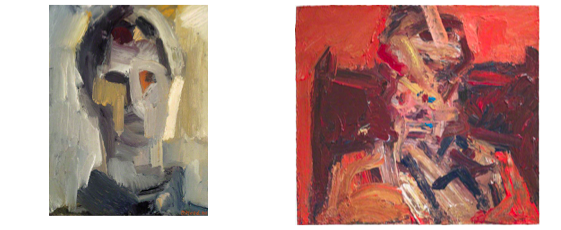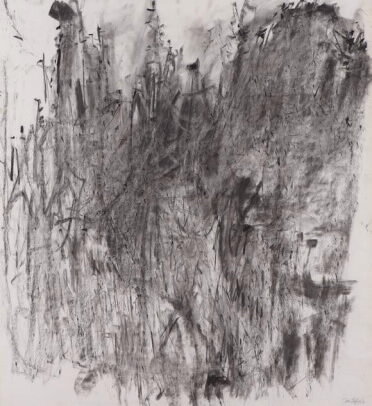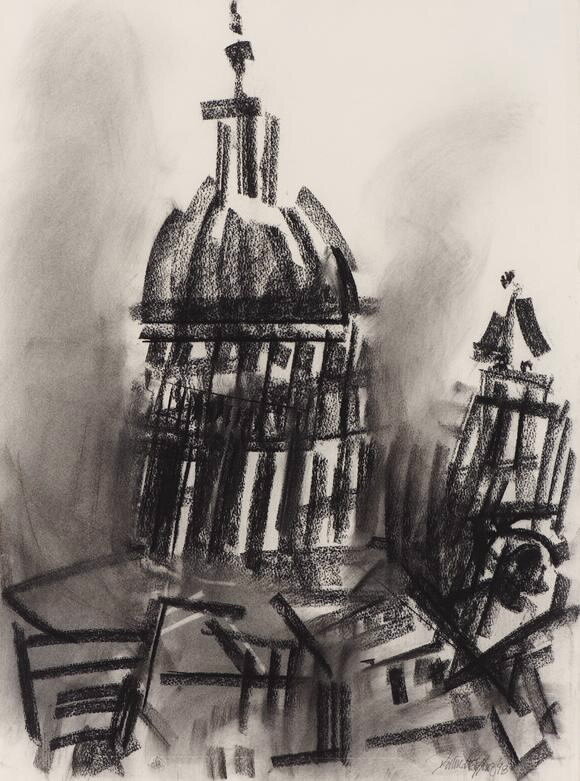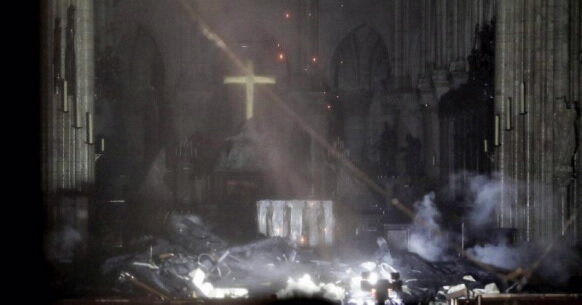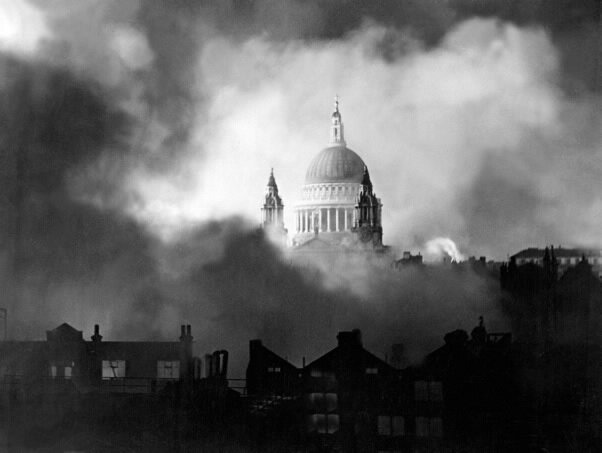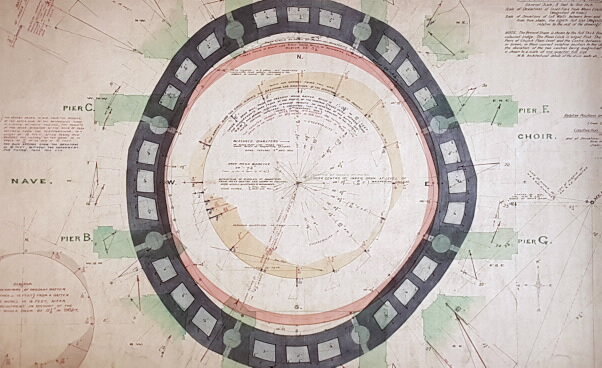Twisted Anchors by Matilda Bjorklund is part of a speculative fiction series influenced by artworks in the BRCA collection. Inspired by the Vorticism influence on Bomberg’s works such the drawing “Family Group” from 1914 and the visual element with the flat and two-dimensional surface, in addition to the rejection of the traditional belief that “art should imitate nature”, this story will feature ghosts that are not traditional in sense of appearance or character. The statues Cubist/ Vorticism style will allow the expression of another side of the human experience and reflect on various humans fates with violence, love and death.
TWISTED ANCHORS
Despite visiting the Vandell estate plenty of times while growing up, Edwin couldn’t recall the place being this echoey. The grand white marble rooms that were formerly filled with artworks and uncomfortable furniture now stood empty, making the house feel like a luxurious empty shoebox. Edwin squinted at the walls and the faint outlines of where paintings used to be. The Vandell estate was meant to live on forever, thought Edwin, as he struggled to remember what particular paintings had been hanging by the estate's entrance. If Edwin had known things would turn out like this, he would have made more of an effort to remember his grandfather’s paintings. However, considering that nothing lasts forever, Edwin saw the proof in that sentiment by realising that he would never see his grandfather's work again.
“Thank you for your cooperation, Mr. Vandell,” said Mr. Bimbley, a proper looking bankman that stood in the open doorway, glancing down his pocket watch. Edwin approached him with his echoing footsteps and handed him an envelope with his final payment. The bankman went through the envelope and frowned a bit at the content.
“Mr. Vandell, your ring please," Edwin looked down at the bankman's gloved hand as it was faced palm up. Judging by Mr. Bimbley's annoyed expression and slight angle towards the busy street, the bankman was eager to leave, similarly to most people in his life. Edwin twisted off his gold wedding ring, bitterly glanced at the engraved "Bianca", and then handed it to Mr. Bimbley.
"With the value of your grandfather's estate and this final payment, your debt should be cleared. We will be in touch in a few days to sign the final documents." Mr. Bimbley tipped his hat and started to walk down the steps but turned around midway.
"I almost forgot, according to Thomas's final will, he wanted you to have this when you had…." Mr. Bimbley trailed off, and Edwin knew why. As the only heir to Thomas Vandell's fortune and art collection, Edwin was supposed to inherit the estate and move in. However, after Bianca's scam, the entire estate had to be given to the bank. It, therefore, was surprising that Edwin was allowed to keep anything from his grandfather. He dared to think it was a family heirloom of some sort or something he could sell to get him back on his feet. Yet when the bankman handed him an old envelope, Edwin's hope deflated.
“We will be in touch in a few days,” and with that, the bankman hurried away. Locking the buzzing street noises outside, Edwin stood alone inside and deciphered the faded ink on the envelope to form the word “secret”. Searching his childhood memories of why this sounded familiar, he went up the stairs to the estate's attic. Standing in his grandfather's studio, where the floors and walls were covered in old dried paint splashes, Edwin gently touched the wall to find the panel that gently budged. When a quiet “click” interrupted the silence, Edwin sighed with relief. That vague image of his grandfather showing him a secret workshop when he was little wasn't a dream after all. It had been over twenty years since he had seen the hidden room, but it had barely changed when he entered. The room was small and had a few round windows showing the rooftops of the city. Cobwebs decorated the furniture and a magazine from ten years ago laid open with an incomplete crossword puzzle. In the middle of the studio, under grimy sheets, stood four statues. As Edwin pulled off the covers and coughed while waving away the dust, he remembered why this room and these statues had been a secret. They were terrible. Thomas Vandell had been a ground-breaking painter and respected by his peers. However, he was far from a talented sculptor. The statues were clunky and oddly shaped, making it seem like they had been made of ice that started to melt and later refroze. His grandfather had always admired the detailed work of Greek statues and their realistic features, but he had developed a theory based on what an old seer told him decades ago. Edwin recalls his grandfather whispering stories to him about how statues become anchors for ghosts that still want to be part of the living world. Realistic sculptures became anchors for heroes and saints, and his grandfather had wondered what ghosts would anchor to a statue that was, for lack of a better word, unconventional. He had set out all those years ago to try out this theory, but Edwin had never heard what happened until now. Opening the letter, Edwin smiled at the recognisable cursive handwriting that had written him letters every school graduation and birthday.
“Dear Edwin, I'm glad you remember my secret. However, upon reading this letter, it has become your secret now. I never finished these statues, as in the process of creating them, I felt they weren't mine to make. Art is about intention and determination. I have started the process, but only you can finish it. When your heart tells you the statues are done, speak the words out loud. If my theory is proven true, my only wish is for it to help you.”
Edwin wandered around the room, looking over the barely human-shaped statues that seemed to look different from every angle. The thought of what to do with them crossed his mind. Maybe he could sell them as a part of the Vandell legacy? Muttering to himself and letting his mind wander through various scenarios, Edwin concluded that it was most likely that no one would want to buy such strange-looking statues. Even if he managed to sell them, he doubted he would get much for them, considering they looked unfinished. They actually were unfinished. The carving tools on the table laid gently organised as if waiting for Edwin to get started. No doubt his grandfather had arranged it last time he was there. The thing was, Edwin wasn't a sculptor. He would not even know where to begin. Picking up a carving tool, his grandfather's theory came to mind again. Could there be some truth to it? Whether he liked it or not, now that the statues were his, they were technically finished as he lacked the skills to continue the work. Figuring it couldn’t hurt, Edwin shrugged his shoulders, put the letter in his breast pocket and said,
"You are done".
There was an expecting silence at first. Edwin didn’t have any experience with the supernatural or otherworldly phenomenon. Still, he had heard tales of flying objects and written messages on the walls from seances his friends used to visit. The silence continued but became less and less expecting. Edwin pinched the bridge of his nose and closed his eyes; maybe he could get the bank to pay for the statues or get rid of them, as they now technically owned the estate. He sighed and turned around to leave when something made him stop in his tracks.
“Now why are ye sighing scrawny fella?” A female voice with a thick Irish accent took over the room. Edwin didn't dare to turn around; perhaps it was only his imagination. Maybe the last few months of stress and heartache had finally turned him mad?
"Look at the state o'you, what got ye so troubled? There was a faint whooshing sound behind him, and suddenly it sounded like there were multiple people in the room with him.
"Maybe it is hay fever?" This time it was a male voice with an accent that Edwin didn't recognise. The Irish woman made a dismissive sound.
“In October? Not a chance,” she huffed.
“Lack of sun God?” A deep female voice chimed in, speaking the words so slowly and carefully but still with a power that made the words honey-like.
"Don't know about yer God, but season sadness could be it,” They continued to talk to each other, coming up with reasons for Edwin's sad presence. Whilst the voices were occupied discussing amongst themselves, he turned around to see where the voices came from. Either sitting on top of the statues or leaning against them were the apparitions of four ghosts. The young Irish woman was a petite figure with fiery auburn hair and dirt on her shoes. Across her sat a Japanese man with his black hair tied up, and laughter lines by his eyes that became prominent when he smiled at the woman's eccentric arm movements when trying to explain the expression “get up the yard”. On top of a statue, as if riding its shoulders, a dark-skinned woman sat and adjusted her jewellery. She had gold cuffs on her arms and legs, as well as row after row of beaded necklaces. She looked like ancient royalty from a civilisation that history books probably didn't know much about. Below her, sitting on the floor, was a young boy in a school uniform. He didn't speak but listened attentively to the chatter.
“So ye finally turned around?” The ghosts fell silent and looked at Edwin. He didn't know what to do, so he did what his mother told him to do when meeting new people. He straightened his back and made a slight bow.
"I'm Edwin,” he started but stopped when panic crept into his mind, whispering this was all in his head. It probably wasn’t wise to interact with figments of your imagination. It was a nervous tick, but Edwin went to fidget with his wedding ring, only to feel nothing but skin.
"I'm Saoirse," Edwin looked up and saw Saoirse pointing at the Japanese man.
“This is Kiyoshi Yamamoto, the woman up there is Chantico, and the boy on the floor is Gregory Cardinham,” The other ghosts waved.
“I must be going mad,” pulling his fingers through his messy hair, causing his grandfather's letter to accidentally fall out of his pocket. Saoirse walked over and picked it up.
"His theory was right, ye know. We all have been looking for ages after an anchor that fits, and yer grandpa was the only clever man out there,” Accepting the letter that Saoirse reached out, Edwin figured that he couldn’t be imagining it. It was too real.
“Besides, living in a fancy place like this, what ye got to worry about?” Saoirse smiled brightly at him, but Edwin couldn’t return the gesture.
"Actually, I don't live here. I barely got a penny to my name," The words made Saoirse pause a bit before she curtsied in front of him.
“Ah, a poor fellow like myself. Nice to meet ye penniless man,” Saoirse climbed back up on a statue and smiled cheekily at Edwin's puzzled expression.
“Have ye ever heard of Black 47? If not, count yer blessings. If ye have, count them twice,” she began and went on to talk about her life during the Great Hunger in Ireland. Everyone listened to Saoirse as she vividly told the story of her people and family, of how they had been starving and spent all their days and nights worrying about the harvest.
"However, in Castlebar, Earl Lucan's men ordered us to leave our land as it could not support us anymore. Yet, in the field, there was a wee sprout, one that gave us hope. When the Earl's men came around, I stood my ground, saying that my family refused to leave," It dawned upon Edwin that this was the story of how Saoirse died. He listened attentively, but his focus shifted as he noticed how her face slowly started to change. As she talked about how she got trampled to death by the Earl's horses, Saoirse's soft face twisted itself into something unrecognisable. Her nose looked broken, and her forehead caved in. Soon her arms and legs dislocated themselves, causing her to look like a broken doll. Saoirse kept on talking as usual but caught Edwin's attention again when she looked right at him.
“There are not a lot of anchors out there for a girl trampled to death. Not really a hero or a saint, that's for sure. I lived poor. I died poor. But I'm not less human, am I?”
The other ghosts nodded along.
“But you lost everything. Aren't you mad about it? Everything was taken away from you," the words left Edwin's mouth before he could stop them. It was the slippage of a vulnerability that he had tried to suppress for months, but it slowly unravelled as Saoirse looked at him.
"Don't get me wrong, I'm bloody furious. I've cursed Earl Lucan more than once for what he did to my people. However, despite the poverty, there is one crucial factor in my story that ye need to know,” Edwin took a step closer, almost as if she would whisper the secret of the world to him.
“There is no Great Hunger in Ireland anymore. No wretched Earl either. All that pain eventually turned into something better. Memories still hurt, but life can't always bleed. Wounds are meant to heal," as she said this, her face slowly began to turn back to how she looked before. A snap echoed as her arm jumped back into its socket.
“Are you married?" The question came from Kiyoshi, and Edwin realised what had prompted the question when he saw that Kiyoshi was watching him fiddle with his ring finger. It was a habit, one that seemed to be challenging to quit.
"I was," Edwin started but stopped as he felt the sting in his heart that constantly cut him whenever Bianca entered his mind. Chantico frowned as she pointed at Edwin's chest.
“Murdered heart?" she asked, and Edwin couldn't help but smile at the expression. Everyone knew that Bianca had broken his heart, gambled and partied away his money, and left London under a new alias. He didn't know what her name was now, or if it even had been Bianca to begin with, and to describe his pain as having a broken heart was too mild. Nevertheless, his heart had indeed been murdered. It continued to be so for every day as new revelations came what Bianca had done with his money.
“If your heart was murdered, I know your pain,” said Kiyoshi. In a calm voice, he then went to tell the story of how his love had ended badly. Kiyoshi had been a farmer working for the aristocratic Takahashi family. He was talented and hardworking, and despite all odds, he managed to grow mulberry on the farm. Apparently, the mulberry plants had medicinal uses, and Kiyoshi smiled as he told them how he had helped the family's daughter, Haruhi, with her dizziness using the plant. As a result, they had fallen in love. The issue was that Haruhi was engaged to a man of her father's wishes. Despite this, they decided to run away together. When retelling the events of the night of their escape, everyone sat silent and, sadly, waiting for the worst outcome.
"I stood and waited at our secret meeting place when two men wrestled me down and took me back to the main house. For hours they beat me, kicked me and cut my face, as apparently, while sneaking out to meet me, Haruhi had been caught. Afraid of her father and what he would do if he found out, she had lied and said that I was trying to kidnap her," a sombre expression came across Kiyoshi's face, but it was soon hidden by thick scars that appeared across his cheeks and eyes. As he sighed, his body started to shift, and only parts of him began to drift away. It took a few seconds for Edwin to register what was happening, and he placed a hand over his mouth when he realised where the story was going.
“Her father came to see me, and by his hand, he killed me. His men chopped me into pieces and threw me away in the Shinano River," Kiyoshi's head floated in the air, and his arms, legs, and upper body drifted around a bit in mid-air. Saoirse took his stray ankle that was soaring above her head and pushed it back to him.
“Do you also feel like love is just a fraud?” Kiyoshi looked at Edwin, and behind his scarred skin, there was a faint outline of a smile.
“How could I do such a thing? If I had made it out alive that day, I would have continued to look for it. Dying just made me realise how important love is. I don't know who hurt you, but do they deserve the power to prevent you from truly living? Whether it be love for friends, family, a partner, or yourself, one bad love should not stop all the good ones,” Kiyoshi's body began to re-assemble again, and Gregory helped him with his knee that had drifted across the room. Edwin noticed how Kiyoshi's statue had larger cuts in it and how they connected back to him. His grandfather truly had been right.
“Bond with family and friends?” asked Chantico.
“No, not anymore. My parents died a while back, and I was the glorious son that was supposed to take on the family business, a law firm downtown. I studied to become an attorney, but then I met Bianca. She liked that everyone said I was intelligent and would become something great one day. Little did I know that after using me, no one would look at me the same anymore. I became a dropout as I couldn’t afford the tuition, and my former friends avoided me like the plague, as a pathetic has-been,” Chantico put up her hand, making Edwin follow it with his gaze. She gently patted her statues head and then put it on her knee. Comparing the ghosts to their statues, Saoirse's statue was the most contorted; Kiyoshi's had the most cuts and bumps, while Chantico's was the most disproportioned. Seeing her strong shoulders and assertive posture, he noticed how fragile-looking her legs were in comparison. Chantico nodded.
“Body born broken, but soul was whole,” Chantico came from an ancient civilisation, and after her father passed away, she had become the ruler of her people. Despite not being able to walk due to a birth injury, she wasn't held back. Instead, she proudly recalled how she had protected her people several times by outsmarting their opponents and beasts in the jungle. Saoirse cheered her on, and Chantico gave her a broad smile back.
“Home, people honour soul with statue. When soul moved on, statue was complete,” she began but paused for a bit while looking at her legs.
"Statue was strong, a warrior in the battlefield, standing on two legs. It could not be my anchor; it wasn't me," the rest of the ghosts nodded and reached out to pat Chantico's hand and shoulder. However, Edwin didn't understand.
"They honoured you with a statue of you on the battlefield? That means they looked beyond your injury. They saw you as their protector," began Edwin but stopped when he saw Chantico's gently nodding.
“Yes, but anchors truth. I body and soul. Proud of both. My sons' sons not know real soul. Good or bad, expectations shackles,” Saoirse pointed at Edwin.
“Do ye get it? Other's expectations of you, whether good or bad, doesn't matter. Ye can be a dropout or a goddess-like Chantico here, and it doesn't matter. What ye think of ye only matters. Chantico can't anchor in her statue as she feels it's not her, no why should ye connect to others opinions of ye? And if ye agree with their opinions, then change somethin'."
“Like what?”
Gregory was about to speak, but he fell into a coughing fit as he opened his mouth. It was a rattling sound, and Edwin couldn't believe such horrifying noise came from that young boy. Kiyoshi jumped down, body now intact, and gently patted Gregory's back.
"I believe it's called Pott's disease," Saoirse jumped down as well and sat down next to Gregory. Her face had started to shift again. As the boy continued to cough, his eyes became red, and his back curled itself to form a hunchback, matching his statues forward leaning posture.
“He got tuberculosis at a young age, and it spread to his spine. He died at a boarding school. Poor lad. Sometimes he can't speak without coughing. However, I think what he wants is for ye to go back and finish your degree, Edwin.”
"I can't go back to school. I don't have the means for it," The ghosts looked up at him, and as if it was the simplest thing in the world, Kiyoshi said;
“There is always a way, it might be the most unexpected, but no matter what, we will be here with you, we won't leave,” and just like that, something clicked in Edwin's heart. It wasn't the pain that Bianca had caused, nor the stress of his situation. Instead, this was a warm feeling, one he had not felt in a long time.
“I have to go,” he began, walking towards the secret entrance.
“I will see you soon, promise,” and he was gone. The ghosts remained behind, confused at his sudden departure, but Edwin had realised the situation. The bank owned the estate, and if the new buyer found the statues and decides to alter them in any way, the ghosts would be gone.
“Thank you for your donation, Mr. Vandell,” said the receptionist at Artica, a newly opened art museum in London. Edwin smiled as a response and signed the final paperwork. It had taken him a couple of days, but eventually, he managed to sort things out. The museum was small, but it took care of its art. In the middle of a room stood the four statues, now clean and spotless. The receptionist had ensured Edwin he could come and see them anytime, and that had brought him some comfort.
“Have a nice day, sir,” said the receptionist as Edwin was about to leave. A young man, probably an assistant, stood by the window and put up a sign. As he went out the door, he glanced at the flier and read the words "nightguard wanted". There had been burglaries in the area lately. Despite not having any valuable pieces in their collection, Artica was more about historical and social value than a financial one. Edwin hurried into the museum again and exclaimed before even entering the hall.
“I would like to apply for the Night Guard position!” The receptionist smiled as a response.
Later that evening, when Edwin sat by a desk with candlelight, he watched the four statues and sighed with a sense of relief.
"Now why are ye sighing scrawny fella?" Saoirse's familiar voice filled the room again, and Edwin greeted them all as if they were old friends. He told them about the museum and ensured them that nothing would happen to their anchors, that they were safe. Saoirse eyed Edwin's work uniform and raised an eyebrow.
"I am working here as a nightguard, figured I need to start saving money so I can finish my degree," Gregory's back was now straight, and he looked like a healthy young boy again. He walked cheerfully up to Edwin and handed him a pen.
“Good, I can help you study.”
So, in the end, it wasn´t heroes or saints that helped Edwin back on his feet. Instead, it was four unconventional ghosts with their twisted anchors that had changed his life. No matter when they had lived, or what they had been through, despite their various fates, they all united in the human experience and the beauty of their stories being told.



